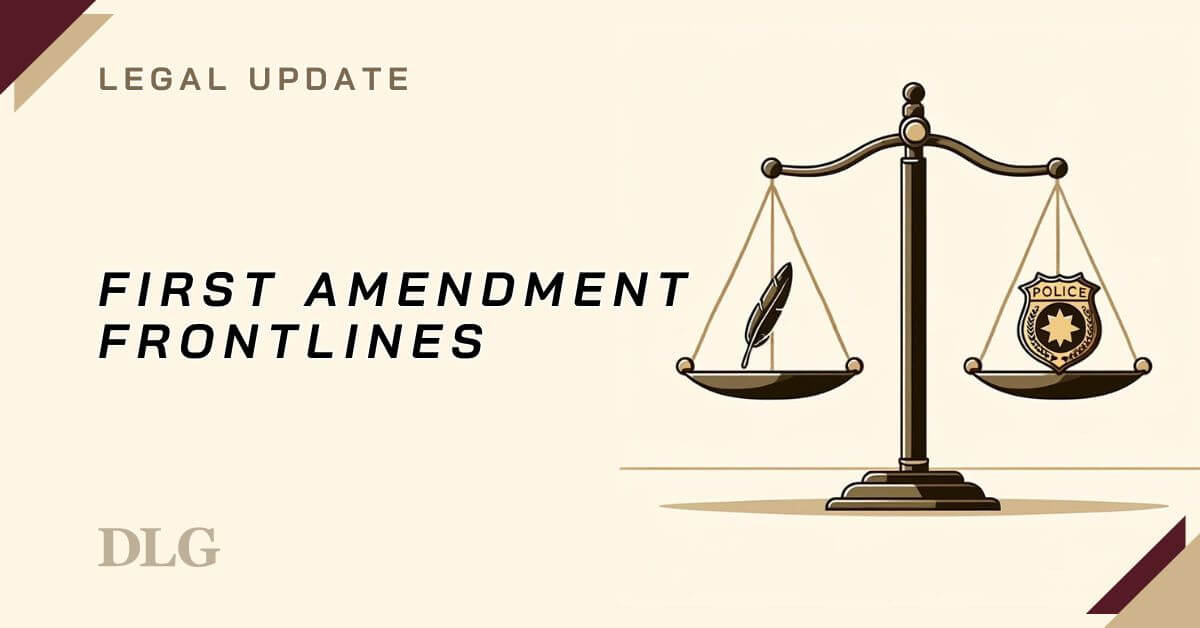Atty. John M. (Jack) Collins, Police Legal Advisor
Martha’s Vineyard, MA
Rather than waiting to be asked by a municipal official, community advocate, religious group or member of the press, chiefs have come to anticipate most “hot button” topics and to prepare for such inquiries. Adverse publicity can result quickly when police officers are accused of mishandling a transgender arrestee. Picketers on various “sides” can appear just as quickly when an officer claims his or her efforts at transgendering have not been handled properly by the department. Lawsuits seeking substantial damages may undermine a chief’s credibility with local government figures, especially if claims are not covered by insurance. Since there is no explicit federal law in place, and approximately 30 states do not have any statute prohibiting employment discrimination based on gender identity, chiefs are understandably concerned about whether and how to proceed when it comes to adopting a policy on dealing with transgender co-workers or interacting with transgender members of the public. The decision by the US Equal Employment Opportunities Commission (EEOC) to investigate and prosecute claims of sexual identity discrimination, using Title VII as the basis, is likely to have chiefs in states without statutory prohibitions questioning whether adopting a department policy on interactions with transgender individuals is advisable until Congress and the courts provide more guidance. Discussions with municipal officials, labor counsel, union leaders and members of the department, as well as the general public are worth considering.
In keeping with Community Policing principles, many chiefs have developed relationships with local groups composed of or representing the LGBT-Q community. Not only will doing so help diffuse otherwise volatile situations, it may provide a sounding board for policy development. Chiefs learned long ago that inviting officers and union leaders to assist in policy development will provide a cadre of supporters when other officers start to find fault with the language. A review process involving the LGBT-Q community, as well as opponent groups, especially if a mutually agreeable policy results, may yield similar results.
Deciding what kind of policy should be developed or amended is the first step should chiefs decide to undertake this endeavor. While they are often contained in the same document, anti-discrimination policies typically emphasize the responsibility of the employer and anti-harassment policies emphasize the responsibility of employees. Virtually all municipalities have some form of “anti-discrimination” policy in place, often in addition to or encompassing one on sexual harassment. How many other categories are included often depends on in which state the city, town or other level of government the police department is located. The sensitive nature of the topic makes adopting a departmental policy prohibiting harassing transgender persons less controversial than one purporting to grant “rights” to such individuals in states where the law does not mandate such position. Specifically referencing “sexual orientation” and “gender identity or expression” in anti-harassment policies is likely to be perceived as consistent with the message officers are used to hearing, i.e., that all employees will be respected and must be able to work free of any kind of harassment. The department’s overall anti-discrimination policy, as well as any specific ones, such as those addressing sexual harassment, surely specify that no form of harassment or offensive conduct directed at individuals based on their personal characteristics or beliefs, will be tolerated. Officers recognize that their jobs require them to treat all persons with respect, including co-workers. Telling officers that they cannot make fun of, tell jokes about or otherwise make the work environment “hostile” for other officers or municipal employees will come as no surprise, since the same principles have been in place for years in more traditional sexual harassment polices. And, obviously, officers would expect that quid-pro-quo harassment of transgender persons would be prohibited. Chiefs are likely to find more confusion, if not outright resistance, when it comes to amending a department’s anti-discrimination policy to include a transgender “rights” provision.
Adopting Expanded Policies
Nationwide, thousands of businesses, including the vast majority of Fortune 500 corporations, have adopted policies that include protection for sexual orientation and gender identity. Chiefs that decide to do the same should be sure that similar wording is included in handbooks or other similar documents. Consistent wording should be included in a department’s “Code of Conduct” and Rules & Regulations Manual, as well as part of any job announcements, on the department’s website and as part of career, recruitment or diversity-related materials. Although a person’s gender expression, or external expression of gender, differs from his or her gender identity, or internal sense of gender, in law and policy the term “gender identity” is often defined or at least understood to include an individual’s gender expression. To ensure that expectations are clearly communicated to employees and potential applicants, chiefs should use the term “gender identity or expression” in policies and other communications.
The following is a list of some of the definitions commonly included in departmental policies:
- Sexual orientation
- An inherent or immutable enduring emotional, romantic or sexual attraction to other people.
- Gender identity
- One’s innermost concept of self as male, female, a blend of both or neither – how individuals perceive themselves and what they call themselves. One’s gender identity can be the same or different from their sex assigned at birth.
- Gender expression
- External appearance of one’s gender identity, usually expressed through behavior, clothing, haircut or voice, and which may or may not conform to socially defined behaviors and characteristics typically associated with being either masculine or feminine.
- Transgender
- An umbrella term for people whose gender identity and/or expression is different from cultural expectations based on the sex they were assigned at birth. Being transgender does not imply any specific sexual orientation. Therefore, transgender people may identify as straight, gay, lesbian, bisexual, etc.
- Gender transition
- The process by which some people strive to more closely align their internal knowledge of gender with its outward appearance. Some people socially transition, whereby they might begin dressing, using names and pronouns and/or be socially recognized as another gender. Others undergo physical transitions in which they modify their bodies through medical interventions.
- Gender dysphoria
- Clinically significant distress caused when a person’s assigned birth gender is not the same as the one with which they identify. According to the American Psychiatric Association’s Diagnostic and Statistical Manual of Mental Disorders (DSM-V), the term – which replaced Gender Identity Disorder in mid-2012– “is intended to better characterize the experiences of affected children, adolescents, and adults.” From a legal perspective, the classification of Gender Identity Disorder is extremely harmful to some trans people, but surprisingly beneficial to others. Chiefs should monitor changes in this terminology debate, as things may change over time. (Note: Homosexuality was diagnosed in the DSM as an illness until 1973, and conditions pertaining to homosexuality were not entirely removed until 1987.)
Other provisions of many anti-discrimination policies include the following:
- The employer is an “equal opportunity employer.” The employer will not discriminate and will take “affirmative action” measures to ensure against discrimination in employment, recruitment, advertisements for employment, compensation, termination, upgrading, promotions, and other conditions of employment against any employee or job applicant on the bases of race, creed, color, national origin, or sex.
- The employer is committed in all areas to providing a work environment that is free from harassment. Harassment based upon an individual’s sex (as well as sexual orientation or gender identity), race, ethnicity, national origin, age, religion or any other legally protected characteristics will not be tolerated. All employees, including supervisors and other management personnel, are expected and required to abide by this policy. No person will be adversely affected in employment with the employer as a result of bringing complaints of unlawful harassment.
Policies specific to transgender individuals should include:
- Adding the term “gender identity” or “gender expression” into the department’s policies as a protected category;
- Include a policy that sets forth “gender transition” guidelines;
- Educate all employees about transgender terms;
- Put into place a privacy policy that protects the privacy of employees who transitioned before joining the department;
- Ensure the department’s dress code is gender neutral and apply it consistently;
- Grant restroom and locker room access according to an employee’s full-time gender presentation;
- Remove discriminatory health insurance exclusions; and,
- If an employee transitions after joining the department, update his or her personnel records.
Recommendation
Chiefs should include a provision in their department’s Anti-Discrimination Policy that prohibits harassment of employees on the basis of gender identity. This is a good management practice and one that should help promote a more caring and stable working environment. While state laws vary when it comes to protections afforded workers, even if gender identity is not covered by a state’s anti-discrimination law, including it in a department’s polices may help avoid federal claims or EEOC investigations.
___________________
Attorney Jack Collins, a former Assistant District Attorney, served for more than 40 years as the General Counsel of the Massachusetts Chiefs of Police Association, is a Past Chair of the IACP’s Legal Officers’ Section, Co-Chairs that groups Annual Training Conference, and for a short time last year was the Police Chief in Edgartown on the island of Martha’s Vineyard.
This publication is produced to provide general information on the topic presented. It is distributed with the understanding that the publisher (Daigle Law Group, LLC.) is not engaged in rendering legal or professional services. Although this publication is prepared by professionals, it should not be used as a substitute for professional services. If legal or other professional advice is required, the services of a professional should be sought.



